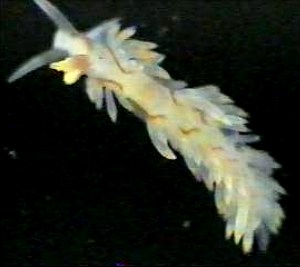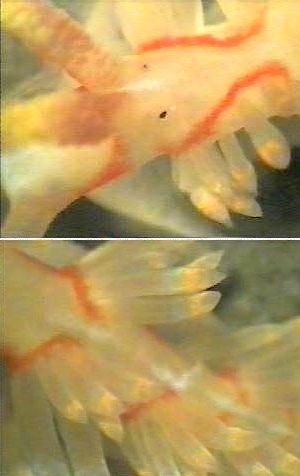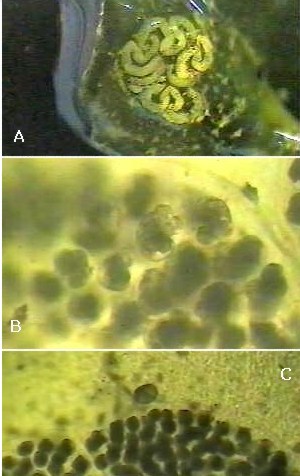Flabellina? from Colombia
September 14, 2001
From: Elianny Dominguez Tejo

Hi Dr. Rudman,
We finally got some good pictures of this nudibranch. We had good luck with this one since it laid an egg mass on our aquarium and we got to see the larvae swimming around. It was found in the Santa Marta region of Colombia (Caribbean) in less than 1m. It is about 8mm long.
The rhinophores are yellow with purple on the base, and they have papillae. Another distinctive feature are the red lateral lines along the body, surrounding the ceratal clusters.
Concerning the eggs: In A you can see the egg mass on Ulva sp. In the other photos you can see the larvae. In C, just outside the egg mass (on the top of it), there is one free larvae, we believe it was the first one to make it out. It looks like a dark capsule. We actually have it on video tape and they move quite fast. We taped them over a period of about 5 hours, and we got to see some of them swimming free on the water.
Best regards,
Elianny Dominguez.
elicelotte@latinmail.com


See Oct 16 2003 message showing this is Berghia rissodominguezi.
Dear Elianny,
These are interesting photos and the orange lines outlining the ceratal clusters should make this animal readily identifiable. Marcus describes an animal with orange curves like this from Brasil (Marcus, E., 1957 -as Berghia coerulescens) and Florida (Marcus, Ev., 1972 - as Berghia verrucicornis). The animals from Florida seem very similar in colour to yours while the Brazilian ones had red rings on the cerata.
I don't know if Marcus' species is really B. verrucicornis or if your animal is really the same. As a first step I think you will need to do a bit of anatomy. If you were able to look at the radula it would remove much of the guess-work from identifying your animals. If I knew the shape of the teeth I should be able to put your species into a genus at least which would make it much easier to know if your animals have a name or not. Do you know how to remove and study the radula? If not let me know and I can give you some background information.
• Marcus,Er (1957) On Opisthobranchia from Brazil (2). Journal of the Linnean Society of London, Zoology, 43(292): 390-486.
• Marcus, Ev (1972) On some opisthobranchs from Florida. Bull. Mar. Sci. 22(2): 284-308.
Best wishes,
Bill Rudman
Related messages
-
Re: Berghia columbina? from the Gulf of Mexico
From: Lynn Zurik, February 11, 2004 -
Berghia rissodominguezi = B. columbina
From: Bill Rudman, February 9, 2004 -
Berghia columbina? from the Gulf of Mexico
From: Lynn Zurik, February 9, 2004 -
Berghia rissodominguezi from Colombia
From: Bill Rudman, October 17, 2003
